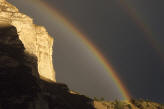It's more than a mountain.
Denali National Park & Preserve features North America's highest mountain,
20,320-foot tall Mount McKinley. The Alaska Range also includes countless
other spectacular mountains and many large glaciers. Denali's more than 6
million acres also encompass a complete sub-arctic eco-system with large
mammals such as grizzly bears, wolves, Dall sheep, and moose.
The park was established as Mt. McKinley National
Park on Feb. 26, 1917. The original park was designated a wilderness area
and incorporated into Denali National Park and Preserve in 1980. The Park
was designated an international biosphere reserve in 1976.
Today the park accommodates a wide variety of
visitor use including wildlife viewing, mountaineering, and backpacking.
It continues to provide a laboratory for research in the natural sciences.
A Message from the Park Superintendent:
"The first Denali Winter Visitor
Center, located in the new Murie Science and Learning Center, opened in
October. Winter visitors enjoying the park during its quietest season will
get current information on winter trails and recreational activities, and
how to best take advantage of this beautiful season at Denali. The Murie
Science and Learning Center staff and partners also develop and present
science-based educational programs for visitors, students from Anchorage
to Fairbanks and beyond, and through state-of-the-art distance learning
technology, to learners around the world.
We are finishing the new Denali
Visitor Center complex, with its 14,000 square foot visitor center, retail
sales and food court building, shuttle bus stop and restroom facility.
These wonderful new facilities will open early next summer. Through these
new facilities you will find many ways to experience and enjoy your park
and to learn about what Denali offers in addition to the “Mountain” and
the large mammals.
Next summer we will begin work on
a new Eielson Visitor Center and on improvements to the Toklat Rest Stop.
The Toklat Rest Stop will be completed in June, and will serve as the
temporary visitor information facility while Eielson is being rebuilt.
When completed in 2007, the new Eielson Visitor Center will be a model of
sustainable design and environmentally sensitive construction. Besides
additional interior space to handle the needs of a growing number of park
visitors, it will include additional indoor and outdoor viewing areas, new
exhibits, interior eating space and room for interpretive programs. It
will remain, however, a simple, low key, wilderness outpost along the
Denali Park Road.
Providing better visitor
facilities is important. Developing new ways to handle the increasing
demand for the Denali Park experience without damaging fragile park
resources and without destroying the very wilderness qualities that you
come here to experience is an important ongoing task. The world-renowned
Denali Park Road experience, riding a bus along the 90-mile gravel road
into the heart of the Denali Wilderness, is possible today only because of
the vision and commitment of previous generations to keep it that way.
Buses have been the primary means of transport into the park since the
park road was built early in the 20 th century. In 1972, when the Parks
Highway opened, bringing the promise of major increases in visitors and
traffic on the park road, park managers closed the road to private
vehicles, and established a bus system to meet visitors’ needs to travel
the park road, get to the backcountry, and see the incredible park
wildlife in its natural environment. Limits on the number of vehicles
using the park road, and the combination of shuttle busses and organized
tours have provided a superlative park experience for millions of park
visitors over the years.
However, portions of the park’s
bus system will likely reach capacity within the next few years. While the
easy solution would seem to be increasing the number of buses to meet
demand, significant increases in buses can reduce the quality of the
experience, both the visitors’ feeling of being out in the wilderness, and
their ability to see wildlife near the road. Denali Park scientists and
managers are working diligently with our partners in the tourism industry,
other agencies and local communities to find reasonable ways to address
this issue. Like previous park managers, we must practice restraint. The
vehicle limits on the park road and bus system were established to provide
a high quality experience. We are also exploring alternatives to the Park
Road experience. One of the most promising includes developing new
facilities along the south side of the park.
Denali National Park and Preserve
belongs to all Americans. Special places like Denali require special care,
and they are part of the legacy we will leave for our children. Whether
you are planning to visit us now or in the future, we look forward to your
support and interest in Denali and its future."

